Introduction: Street Food in North Macedonia
North Macedonia, a small Balkan country, is known for its rich and diverse cuisine. With influences from Turkish, Mediterranean, and Balkan dishes, the street food scene in North Macedonia offers a unique and delicious experience for locals and tourists alike. From savory pies to grilled meats, the street food in North Macedonia is a must-try for any food lover.
Traditional Street Food Dishes
One of the most popular traditional street food dishes in North Macedonia is burek. This savory pastry is made with phyllo dough and stuffed with meat, cheese, or spinach. Another popular dish is ajvar, a roasted red pepper spread that is perfect for dipping bread. Cevapi, a type of grilled sausage, is also a favorite among locals and tourists.
Popular Street Food Markets
The Old Bazaar in Skopje, the capital of North Macedonia, is a popular destination for street food. Here, vendors sell a variety of traditional dishes such as kebapi, shopska salad, and grilled fish. Bitola’s Shirok Sokak, a pedestrian street lined with shops and cafes, is also a great place to sample Macedonian street food.
Health and Safety Concerns
As with any street food scene, there are health and safety concerns to consider. It is important to make sure that the food is prepared in a clean environment, and that the vendor follows proper food safety protocols. It is also a good idea to avoid any street food that has been sitting out for a long time, as it may not be fresh.
Street Food Culture and Customs
In North Macedonia, street food is not just about the food itself, but about the experience. It is common for locals to gather in the streets to enjoy a meal together, and street vendors often have a strong sense of community. Additionally, haggling over prices is a common practice when buying street food in North Macedonia.
Future of Street Food in North Macedonia
As North Macedonia continues to grow and develop, the street food scene is likely to evolve as well. With a focus on sustainability and locally-sourced ingredients, there is an opportunity for street food vendors to incorporate these values into their businesses. Additionally, with the rise of food tourism, there is a growing demand for authentic and traditional street food experiences. The future of street food in North Macedonia looks bright, and we can look forward to seeing how it grows and evolves in the coming years.







